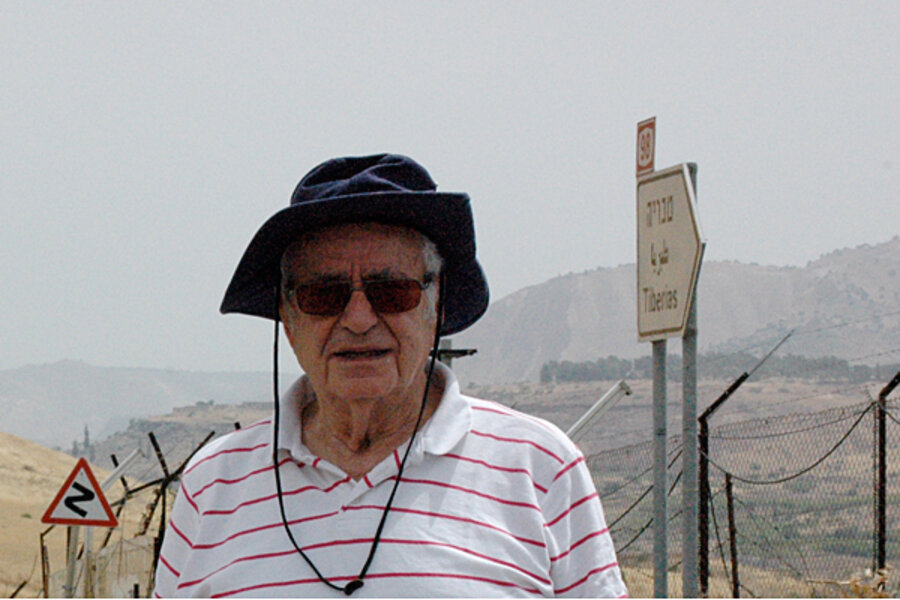Behind the wheel with a witness to Israel's history
Loading...
| Along the Israel-Jordan border
It’s 7:15 a.m. on Shabbat (Saturday) and most of Jerusalem is asleep, but in 15 minutes our tour guide has already whisked us through the 1800s, the 20th-century breakup of the Ottoman Empire, Israel’s conquest of East Jerusalem and the West Bank (the 1948 creation of Israel goes without saying), and into present-day troubles such as the impoverished nomads who live on either side of the highway heading down to the Dead Sea and Jordan beyond.
“These are Bedouins, and nobody has a clue what to do with them,” Prof. Meron Medzini says, waving a hand toward the shacks and the little boys and donkeys that orbit them in search of a bit of toasted grass.
Professor Medzini, a friendly chap who has every right to have retired a decade or two ago, still teaches political science at Hebrew University – “At least I get up in the morning and I know what I’m going to do,” he says. Despite finals coming up, he is spending his weekend driving me and my boss around Israel’s borders with Jordan, Syria, and Lebanon. The field trip extraordinaire includes not only an eye-opening look at the geography of Israel’s security, but also a dizzying tour of modern Israeli history.
Medzini is no stranger to such tours. Well before I was born, he introduced the Monitor’s legendary editor, Erwin Canham, to Israel’s founding father, David Ben-Gurion. In the course of his storied career, he worked side by side with the country’s first (and so far only) female prime minister, Golda Meir – a childhood friend of his mother’s – and Levi Eshkol, the leader who presided over the 1967 war with Israel’s Arab neighbors, which drastically changed the landscape both politically and demographically as Israel’s settlement enterprise began sprouting throughout the West Bank.
And this is one of the most fascinating parts of the tour, indeed of working in Israel today: that it is still possible to meet people who participated in the founding of the state and its formative early years, or worked closely with those who did. In an American context, it would perhaps be akin to meeting George Washington’s friend, or Thomas Jefferson’s aide.
Medzini knew Golda Meir best, later writing a biography of her ("Golda: A political biography").
As we drive along the border with Jordan, lined with barbed wire, mines, sensors, and daily Israeli patrols looking for footprints – a fence put in place shortly after the 1967 war and kept in place even after the 1994 peace with Jordan – Medzini recounts Meir’s rocky shuttle diplomacy with Jordan’s King Abdullah.
We pull off the road to see a hydroelectric dam on the Yarmuk River, where the two met “by accident.” Abdullah developed a “headache” after lunch, Medzini recalls, and had to retire to the bungalow of the stationmaster. Golda was there.
But Abdullah disliked the fact that Israel had tapped a woman to deal with him and their diplomacy was perhaps not as fruitful as either side had hoped.
Her secret visits with Abdullah’s successor, King Hussein, had a warmer tenor.
“Golda met Hussein seven or eight times,” recalls Medzin.
The press would ask Hussein, “Did you see Golda?”
And he would coyly respond, “Yes, on television.”
During the 1973 war, Hussein informed Golda that Jordan had to take some “token” action, says Medzini.
“Hope you don’t mind,” Hussein essentially said. “We’ve sent a brigade to the Golan.”
“So we were shooting at them in the Golan and trading with them 100 miles away,” says Medzini, chuckling.
There are definitely more somber parts of the tour as well, though, such as a stop at the Nahariya hydroelectric dam on the Israel-Jordan border where in 1997, three years after the two countries made peace, a Jordanian soldier inexplicably opened fire on a high school field trip and killed seven teenage girls.
Hussein personally visited each of the seven families and asked forgiveness, says Medzini.
In a land where the phrase "an eye for an eye, and a tooth for a tooth" was coined, Hussein's gesture seems like a noble answer to the criticism of Christians such as former US Sen. Warren Austin (R) of Vermont, who famously said that Jews and Muslims should reconcile their differences in a Christian spirit.








